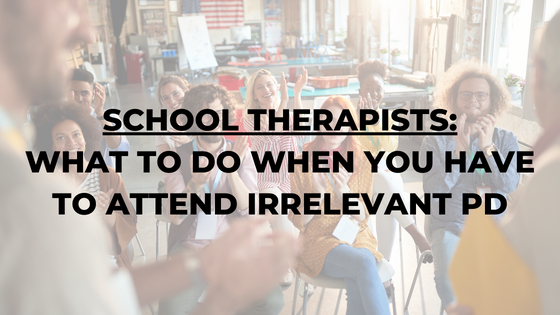You’ve got a backlog of reports to do. Next week there’s a staff in-service day, and you’re hoping to use it to finally make a dent in the paperwork that’s been piling up.
And then the email comes. Everyone in the building is required to attend the district professional development in the morning about the new curriculum initiatives.
You sigh, and then vent a little bit to other support staff who also feel ignored by the school administrators. You’d like, for once, to feel like someone thought of you when they planned out the in-service days.
There are a lot of ways to handle this predicament. You can follow some advice on “leading up” to your school administrator, like I discussed with former principal, Jethro Jones, in episode 112 of De Facto Leaders.
You can create a strategy for how you interact with your building leadership, like I discussed with related service director, Marva Mount, in episode 97.
Or you can develop a system for how you communicate with administrators, like I discussed in episode 100 with principal, Gastrid Harrigan.
But what do you do about the loneliness that comes from being the only one in your discipline working in your building?
How do you create a scenario where you feel a sense of belonging and recognition for your expertise?
I wanted to share a counterintuitive, but powerful way for school therapists to make this happen.

Go from overlooked to go-to resource
People default to what’s familiar; and that includes the people they interact with. If the teachers in each grade level are used to collaborating with other teachers in their area, those are going to be their “go-to” people they utilize for support and ideas.
When people get busy, they’re going to strive for efficiency. It’s much easier to reach out to someone you regularly talk to when you’re in a bind as opposed to someone you don’t know as well. And when your brain gets tired, you’re going to go to whoever comes to mind first. This means you might not think to reach out to certain people who could be SUPER helpful.
Humans do this all the time. And teachers and school administrators are humans (who happen to have really demanding jobs).
In my experiences, when related service providers are left out of conversations, it’s often not done maliciously. That’s why staying top-of-mind is essential if you’re a school therapist.
One of the most effective ways to do that?
Make yourself useful, in a way that matters to other people.
Anticipating the needs of others in your building is going to be difficult if you don’t understand their day-to-day on a deep level.
This means you’ll need to stay in the loop about what’s happening in your building, what information and support the teachers have, and what challenges they’re having with any district-wide initiatives.
So that irrelevant professional development? It might be more relevant than you think.
If you’re in a related service provider role; one of the most important things you bring to the table on a school team is the ability to support teachers.
But how you offer that support is important. It can’t be offered in a way that feels like you’re putting more work on teachers’ plates.
I’ve made this mistake on many occasions.
I can’t tell you how many times I’ve had conversations with teachers, and my energy was like, “Look at this cool thing I came up with you can try in your classroom.”
The only problem was that most of my “cool things” didn’t align with the immediate fires and priorities the teachers had; which means they politely took my suggestions but didn’t implement them.
I knew what I was suggesting was a win for everyone. For me, the teachers, and the students. But I wasn’t listening to what the teachers thought was important.
This is a common occurrence with special education professionals, because special education accommodations can feel like something extra teachers need to do on top of many other demands.
This is why accommodations for ADHD, autism, dyslexia, developmental language delays, or other things that impact language and cognition aren’t always consistently implemented in schools.
This is often a systems issue more so than it’s a people issue. I don’t think we can place the blame on any one particular group of people.
But even if you didn’t cause the problem; you can be part of a solution.

Get what you want by helping others get what they want.
If a school needs to make changes at the general education level and they don’t have a solid curriculum in place in the core content areas, you’re going to have a very difficult time making your “cool thing” be high priority if there’s not an obvious connection.
The leadership and other staff may be too overwhelmed to think about one more thing, unless you can show how what you’re offering is going to align with what’s important to them.
That’s why becoming the “go-to” executive functioning specialist in your building can be your ticket in.
A large portion of the classroom accommodations and supports for students with ADHD, autism, DLD, and dyslexia relate to supporting executive functioning.
This includes things like clear boundaries and expectations, modeling self-talk, supporting strategic thinking and planning, visuals to support time perception, and self-evaluation.
All of these things are going to make implementation of core curriculum more effective not just for students receiving specialized services; but for ALL students.
That’s why executive functioning shouldn’t just be a special education initiative, it should also be a universal design initiative at the general education level.
I share more about how that could look in this conversation with Tanya Sheckley on the Rebel Educator podcast.
If these supports become part of the system and habitual for teachers at the general education level, students get access to universal supports.
This would not eliminate the need for accommodations and services on IEPs and 504s; that’s not the point.
The goal is to put things in place that are NECESSARY for some, but BENEFICIAL for all. This can enhance learning for everyone and make things much more streamlined for those who do need something above and beyond general education.

Position yourself as an expert
If you’re a related service provider; you can be a huge asset in universal design initiatives.
There’s a path forward for you to make that happen.
STEP 1: Solidify your skills within your discipline. If you’re a new clinician, it’s okay to get your bearings before you embark on a huge district or building initiative. Even if you’re more experienced but there’s one area that’s always been your Achilles’ heel, create a plan to build your skills in this area so it’s not taking up so much mental bandwidth. This will free up energy for you to think bigger in the next steps.
STEP 2: Make the irrelevant become relevant. The next time you feel annoyed about a professional development related to district-level initiatives outside of your discipline, pause for a second and reflect. Is it really irrelevant? I know it’s frustrating when you have a long to-do list and you have to go to another training; but if you want to be part of the team, you need to align yourself with the district’s mission. If it has to do with anything related to what’s happening in classrooms, I PROMISE it’s relevant to you. Start to think about ways you can draw those connections for yourself and others. It will pay off later. Plus, the more you can connect the dots for people, the more you’ll be able to advocate for things that are directly relevant to your discipline later on.
STEP 3: Become the executive functioning expert in your building. The more you know about this area, the more you’ll be able to show people how it’s relevant to their current pain points in their content area. The same goes for behavior management and mental health. Executive functioning is the glue that holds all the disciplines and content areas together. Others may not see these connections yet, which is why you need to know what things they’re currently prioritizing. Help them with their priorities and help them get some wins. There will come a time when you’ll be able to use your knowledge; and you’ll be able to do that more effectively if you’ve built up that trust first.
STEP 4: Form alliances. Knowledge of executive functioning can help you form alliances with others in adjacent disciplines so you can work together. The best way to break down silos is to team up with others who also feel siloed. For example, if you’re the only SLP in your building, instead of just seeing yourself as the “lone wolf SLP”, see yourself as part of the related service provider team. This could include the counselor, special education teachers, social workers, psychologists, or other support staff. These can become “your people”. You may also get to the point that you see yourself belonging to other groups associated with different initiatives along with teachers or administrators. Here’s where you can really start making things happen.

Your Road Map
Some things are people issues. For example, someone on a school team needs to develop a set of skills to provide direct therapy. These issues can often be solved by providing necessary training and mentorship, as well as resources. These tend to be more micro level.
Other things are systems issues. Systems issues can create people issues on top of other things. Solving them is much more complex because they’re macro level issues. As a related service provider, you may initially start your career focusing more on the “micro”, which could include honing your clinical skills and developing your clinical protocols.
As you mature in your career, you can evolve to thinking more “macro”, which is what’s necessary to spearhead universal design initiatives impacting general and special education. While the role of a school administrator is to focus on these systems issues, they often need subject matter experts like school therapists to “lead up” and support them.
I created the School of Clinical Leadership to help related service providers do that.
The School of Clinical Leadership is a program for psychologists, social workers, speech pathologists, counselors, occupational therapists, or other service providers who want an evidence-based plan for supporting students socially, emotionally, and academically.
Many K-12 teams aren’t using effective service-delivery models or strategies to build executive functioning.
But it only takes ONE team member to take the lead and get the team on track. That person can be YOU.
With the right system, it’s possible, even with limited time and resources, and even if you’re not in an “official” leadership position.
The School of Clinical Leadership gives you the tools and systems you need to design services that build resilience and independence.
But it doesn’t stop there.
I’ll also help you develop the systems and operating procedures needed to make it a reality.
You can learn more about how to become a member here.


